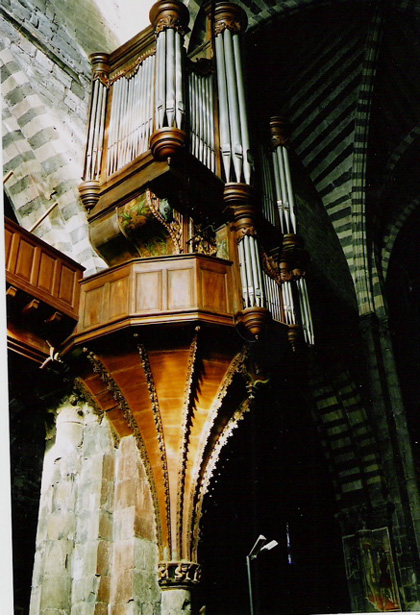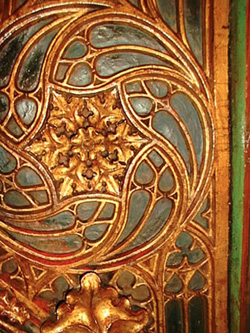

Orgue : 3 keyboards , pedalboard - 27 stops

Composition :
| Positif - 49 notes | Grand-Orgue - 49 notes | Pédale - 30 notes |
| Bourdon 8' | Montre 16' | Flûte 8' |
| Second 8' | Montre 8' | Trompette 8' |
| Prestant 4' | Bourdon 8' | |
| Nazard 2 2/3' | Prestant 4' | |
| Doublette 2' | Flûte 4' | |
| Tierce 1 3/5' | Nazard 2 2/3' | |
| Larigot 1 1/3' | Doublette 2' | |
| Plein-jeu III rangs | Tierce 1 3/5' | |
| Cromorne 8' | Cornet V rgs | |
| Fourniture III rgs | ||
| Récit - 25 notes | Cymbale IV rgs | |
| Voix humaine 8' | ||
| Cornet V rgs | Trompette 8' | |
| Clairon 4' |
coupler : pos/G.O.
Pedalcoupler : G.O.
Tremulant

Built in 1464, it was offered very certainly by "dauphin" Louis, future Louis XI.
This present was a luxurious instrument completely colored of lively colors : red, blue, green, orange and black, and decorated with magnificent golden sculptures.
We can imagine that the instrument was a real precious jewel put on its "swallow's nest" which is also polychromatic and gilded.
In 1635, one add it a "positif de dos".
In 1750, the Swiss organ builder Samson Scherrer adds in front of the top of the case an envelope of 18th style and replace the positive of 1635 by an other one, with the same case than the grand-Organ. The main elements down from the Gothic case are still present behind the 18th case, what allowed to make a reconstruction of the case of origin (see drawing in the detailed study))
The reconstruction of the case and the re-creation of the instrumental and mechanical parts of this organ thus asked for a very important work of study.


vidéos: